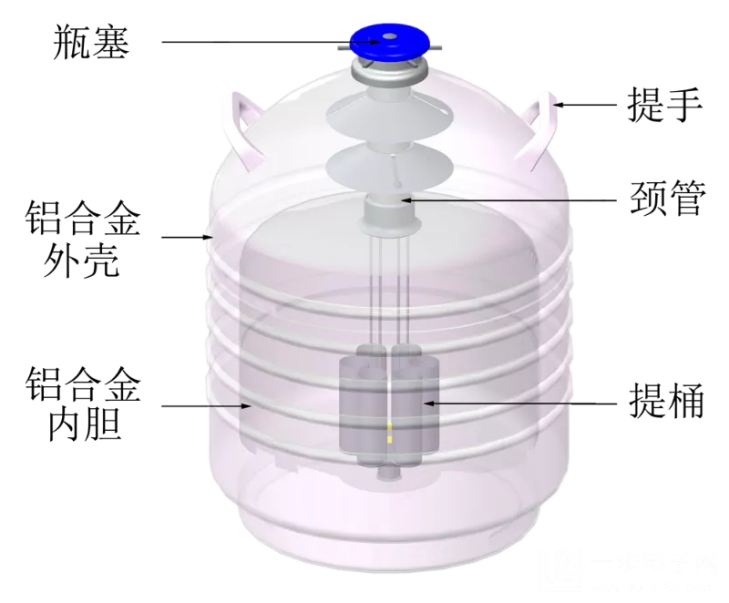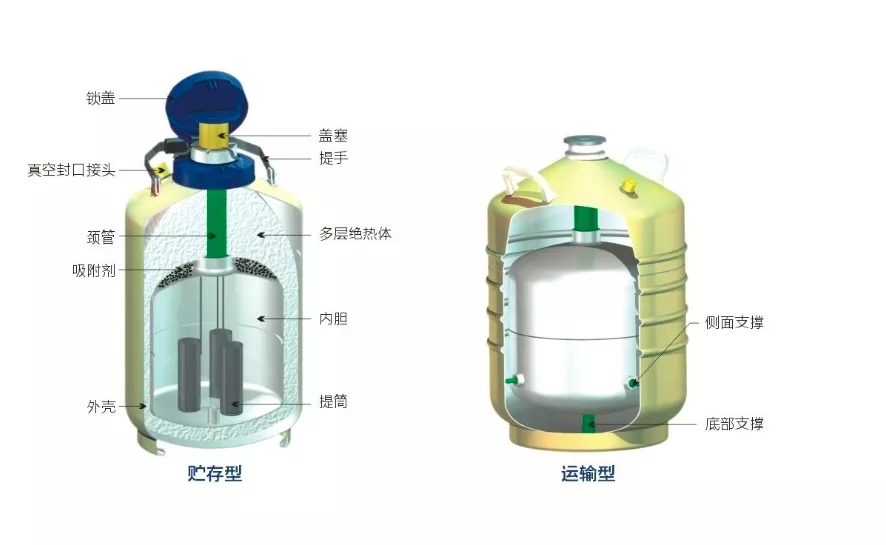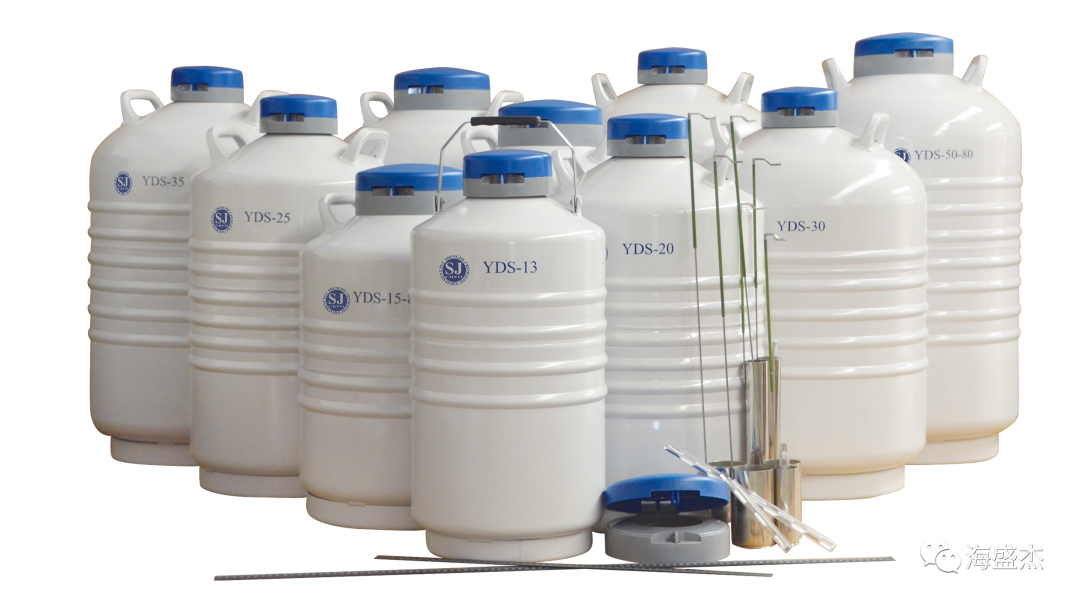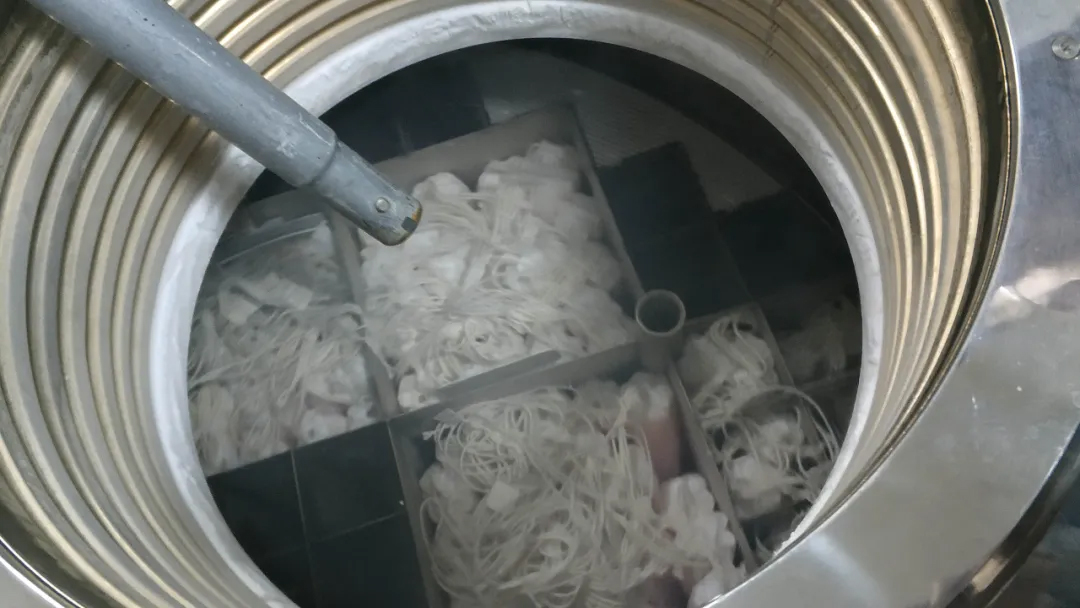At present, artificial insemination of frozen semen has been widely used in animal husbandry production, and the liquid nitrogen tank used to store frozen semen has become an indispensable container in aquaculture production. The scientific and correct use and maintenance of the liquid nitrogen tank is particularly important for the quality assurance of the stored frozen semen, the extension of the service life of the liquid nitrogen tank and the safety of the breeders.
1.The structure of the liquid nitrogen tank
Liquid nitrogen tanks are currently the best container for storing frozen semen, and liquid nitrogen tanks are mostly made of stainless steel or aluminum alloy. Its structure can be divided into shell, inner liner, interlayer, tank neck, tank stopper, bucket and so on.
The outer shell is composed of an inner and an outer layer, the outer layer is called the shell, and the upper part is the tank mouth. The inner tank is the space in the inner layer. The interlayer is the gap between the inner and outer shells and is in a vacuum state. In order to improve the thermal insulation performance of the tank, insulation materials and adsorbents are installed in the interlayer. The tank neck is connected to the inner and outer layers of the tank with a heat-insulating adhesive and keeps a certain length. The top of the tank is the mouth of the tank, and the structure can discharge the nitrogen vaporized by the liquid nitrogen to ensure safety, and it has thermal insulation performance to reduce the amount of liquid nitrogen. The pot plug is made of plastic with good thermal insulation performance, which can prevent the large amount of liquid nitrogen from evaporating and fix the sperm cylinder. The vacuum valve is protected by a cover. The pail is placed in the tank in the tank and can store various biological samples. The pail handle is hung on the index ring of the tank mouth and fixed with a neck plug.

2. Types of liquid nitrogen tanks
According to the use of liquid nitrogen tanks, it can be divided into liquid nitrogen tanks for storing frozen semen, liquid nitrogen tanks for transportation and liquid nitrogen tanks for storage and transportation.
According to the volume of the liquid nitrogen tank, it can be divided into:
Small liquid nitrogen tanks such as 3,10,15 L liquid nitrogen tanks can store frozen semen in a short time, and can also be used to transport frozen semen and liquid nitrogen.
Medium-sized liquid nitrogen tank (30 L) is more suitable for breeding farms and artificial insemination stations, mainly used to store frozen sperm.
Large liquid nitrogen tanks (50 L, 95 L) are mainly used to transport and distribute liquid nitrogen.

3. Use and storage of liquid nitrogen tanks
The liquid nitrogen tank should be kept by someone to ensure the quality of the stored semen. Since it is the job of the breeder to take the semen, the liquid nitrogen tank should be kept by the breeder, so that it is easy to grasp and understand the liquid nitrogen addition and semen storage conditions at any time.
Before adding liquid nitrogen to the new liquid nitrogen tank, first check whether the shell is recessed and whether the vacuum valve is intact. Secondly, check whether there is any foreign matter in the inner tank to prevent the inner tank from being corroded. Be careful when adding liquid nitrogen. For new tanks or drying tanks, it must be added slowly and pre-cooled to prevent damage to the inner tank due to rapid cooling. When adding liquid nitrogen, it can be injected under its own pressure, or the transport tank can be poured into the storage tank through the funnel to prevent the liquid nitrogen from splashing. You can line the funnel with a piece of gauze or insert the tweezers to leave a gap at the entrance of the funnel. To observe the height of the liquid level, a thin wooden stick can be inserted into the bottom of the liquid nitrogen tank, and the height of the liquid level can be judged according to the length of the frost. At the same time, it should be noted that the environment is quiet, and the sound of liquid nitrogen entering the tank is an important basis for judging the liquid nitrogen tank in the tank.

△ Static Storage Series-Animal Husbandry Safety Storage Equipment △
After adding liquid nitrogen, observe whether there is frosting on the outer surface of the liquid nitrogen tank. If there is any indication, the vacuum state of the liquid nitrogen tank has been damaged and cannot be used normally. Frequent inspections should be made during use. You can touch the shell with your hands. If you find frost on the outside, you should stop using it. Generally speaking, if liquid nitrogen is consumed 1/3~1/2, it should be added in time. In order to ensure the activity of frozen semen, it can be weighed or detected with a liquid level gauge. The weighing method is to weigh the empty tank before use, weigh the liquid nitrogen tank again after filling up the liquid nitrogen, and then weigh it at regular intervals to calculate the weight of the liquid nitrogen. The liquid level gauge detection method is to insert a special liquid level gauge stick into the bottom of the liquid nitrogen tank for 10 s, and then take it out later. The length of the frost is the height of the liquid nitrogen in the liquid nitrogen tank.
In daily use, in order to accurately determine the amount of added liquid nitrogen, you can also choose to configure corresponding professional instruments to monitor the temperature and liquid level in the liquid nitrogen tank in real time.
SmartCap
The “SmartCap” specially developed by Haishengjie for aluminum alloy liquid nitrogen tanks has the function of real-time monitoring of liquid nitrogen tank liquid level and temperature. This product can be applied to all liquid nitrogen tanks with diameters of 50mm, 80mm, 125mm and 216mm on the market.
The smartcap can monitor the liquid level and temperature in the liquid nitrogen tank in real time, and monitor the safety of the semen storage environment in real time.

Dual independent systems for high-precision level measurement and temperature measurement
Real-time display of liquid level and temperature
The liquid level and temperature data are remotely transmitted to the cloud, and data recording, printing, storage and other functions can also be realized
Remote alarm function, you can freely set up SMS, email, WeChat and other methods to alarm
The liquid nitrogen tank for storing semen should be separately placed in a cool place, indoor ventilated, clean and hygienic, free of peculiar smell. Do not place the liquid nitrogen tank in the veterinary room or pharmacy, and it is strictly forbidden to smoke or drink in the room where the liquid nitrogen tank is placed to avoid peculiar smell. This is especially important. No matter when it is used or placed, it should not be tilted, placed horizontally, placed upside down, piled up, or hit each other. It should be handled gently. Open the lid of the can stopper to lightly lift the slow lid to prevent the can stopper from falling off the interface. It is strictly forbidden to place objects on the lid and plug of the liquid nitrogen biological container, which will cause the evaporated nitrogen to overflow naturally. It is strictly forbidden to use self-made lid plugs to block the mouth of the tank, so as to prevent the internal pressure of the liquid nitrogen tank from increasing, causing damage to the tank body, and serious safety problem

Liquid nitrogen is the most ideal cryogenic agent for preserving frozen semen, and the temperature of liquid nitrogen is -196°C. Liquid nitrogen tanks used as artificial insemination stations and breeding farms for storing frozen semen should be cleaned once a year to avoid corrosion in the tank due to stagnant water, semen contamination, and multiplication of bacteria. Method: First scrub with neutral detergent and appropriate amount of water, then rinse with clean water; then put it upside down and dry in natural air or hot air; then irradiate it with ultraviolet light. Liquid nitrogen is strictly prohibited to contain other liquids, so as to avoid oxidation of the tank body and corrosion of the inner tank.
Liquid nitrogen tanks are divided into storage tanks and transportation tanks, which should be used separately. The storage tank is used for static storage and is not suitable for long-distance transportation in a working posture. In order to meet the conditions of transportation and use, the transportation tank has a special shock-proof design. In addition to static storage, it can also be transported after being filled with liquid nitrogen; it should be firmly fixed during transportation to ensure safety, and avoid collision and severe vibration as much as possible to prevent tipping.
4. Precautions for storage and use of frozen semen
Frozen semen is stored in a liquid nitrogen tank. It must be ensured that the semen is submerged by liquid nitrogen. If it is found that the liquid nitrogen is insufficient, it should be added in time. As the storage and user of the liquid nitrogen tank, the breeder should be familiar with the empty weight of the tank and the amount of liquid nitrogen contained in it, and measure it regularly and add it in time. You should also be familiar with the relevant information of the stored semen, and record the name, batch and quantity of the stored semen by number so as to facilitate access.

When taking frozen semen, first take out the jar stopper and place it aside. Pre-cool the tweezers. The lifting tube or gauze bag should not exceed 10 cm from the jar neck, not to mention the jar opening. If it has not been taken out after 10 seconds, the lift should be lifted. Put the tube or gauze bag back into the liquid nitrogen and extract after soaking. Cover the jar in time after taking out the semen. It is best to process the sperm storage tube into a sealed bottom, and allow liquid nitrogen to submerge the frozen sperm in the sperm storage tube. In the process of sub-packing and thawing, the operation must be accurate and skillful, the action must be agile, and the operation time should not exceed 6 s. Use long tweezers to take out the thin tube of frozen sperm from the liquid nitrogen tank and shake off the residual liquid nitrogen, immediately put it in 37~40℃ warm water to submerge the thin tube, gently shake it for 5 s (2/3 dissolution is appropriate) After the discoloration, wipe off the water droplets on the tube wall with sterile gauze to prepare for insemination.
Post time: Sep-13-2021











